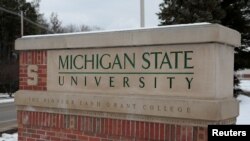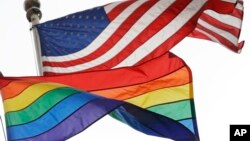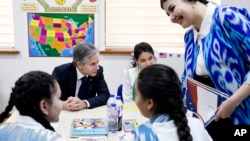Student Union
Fewer Foreign Students Enrolling in US College and Universities

More international students come to the U.S. from around the world for higher education than any other country, but those metrics show stagnation -- and steep declines from some countries -- for the second year after decades of growth.
The annual Open Doors report, compiled by the Institute for International Education with the U.S. State Department and released Monday, for the 2018-2019 school year showed enrollment of 1,095,299 international students among 19,828,000 total students in institutions of higher education in the U.S.
That makes international students 5.5% of all college and university students in the U.S.
The numbers showed a slight increase in total international enrollment, 0.05% from the previous year, but a decrease in new international student enrollment, -0.9%.
Decreases were seen in undergraduate (-2.4%), graduate (-1.3%) and non-degree (-5.0%) trends, as well.
China sent the most students -- 369,548 -- comprising 33.7 percent of all foreign students, a 1.7 percent increase from the previous year.
India sent the second-largest number -- 202,014 -- or 18.4% of all college and university students, a 2.9% increase from the previous year.
But several other countries, in descending order of number of students sent to the U.S., showed declines: South Korea (-4.2%), Saudi Arabia (-16.5%), Canada (0.8%), Vietnam (0.3%), Taiwan (4.1%), Japan (-3.5%), Brazil (9.8%), Mexico (-1.5%), Nigeria (5.8%), Nepal (-0.3%), Iran (-5.0%), the United Kingdom (-2.7%), Turkey (-3.4%), Kuwait (-9.8%), Germany (-8.5%), France (-1.0%), Indonesia (-3.4%), Bangladesh (10%), Colombia (1.1%), Pakistan (5.6%), Venezuela (-7.3%), Malaysia (-6.8%) and Spain (-3.0%).
What is turning off international students from coming to study in the U.S.?
Institutions polled indicated the slowdown includes the high cost of tuition at U.S. colleges and universities, difficulty in getting visas or the insecurity of maintaining a student visa throughout a student's education, students feeling a lack of welcome in the U.S., negative political rhetoric and news of crime in the U.S.
“We are happy to see the continued growth in the number of international students in the United States and U.S. students studying abroad,” said Marie Royce, assistant secretary of state for Educational and Cultural Affairs.
“Promoting international student mobility remains a top priority for the Bureau of Educational and Cultural Affairs and we want even more students in the future to see the United States as the best destination to earn their degrees," Royce said. "International exchange makes our colleges and universities more dynamic for all students, and an education at a U.S. institution can have a transformative effect for international students, just like study abroad experiences can for U.S. students.”
The Optional Practical Training (OPT) program showed a 9.6% increase of involvement, indicating that students who were in the international student pipeline of study in the U.S. were taking advantage of OPT, which allows them to stay in the U.S. after graduation for one to three years, depending on their field of study. Science, technology, engineering and math graduates are granted longer OPT visas than some other courses of study.
The most popular fields of study for international students are in STEM (science, technology, engineering and math) fields. But declines in enrollments were seen there, as well: engineering (-0.8%), business and management (-7.1%), intensive English (-14.8%) and education (-4.7%).
International students who came to the U.S. to study agriculture increased by 10.3%.
International students contributed $41 billion to the U.S. economy in the 2018-2019 academic year, according to NAFSA: Association of International Educators.
In 2017, the U.S. Department of Commerce said international students contributed $42 billion to the U.S. economy.
See all News Updates of the Day
- By VOA News
Michigan State international students get their own space

Michigan State University in East Lansing, Michigan, is setting aside a space in the International Center for international students.
Nidal Dajani, vice president of the school's International Student Association, said that the club plans to use the space to host events and hopes to collaborate with other student groups.
- By Dylan Ebs
International students find community during Pride Month

For LGBTQ+ international students, Pride Month, observed in June, is a unique time to reflect.
They hold on to multiple identities — both their LGBTQ+ identity and their cultural background — but coming to terms with them is not always easy.
For graduate student David Zhou, these identities can feel conflicting as transgender rights in China remain a controversial issue and spaces for LGBTQ people close. Zhou, 25, is transgender and pursuing an education in the STEM field at an urban university in the Midwestern United States.
VOA is using a pseudonym for Zhou’s first name and is not naming his university to protect his identity due to safety concerns back home in China. Zhou is not open about his transgender identity to his family.
During Pride Month, Zhou said he attended multiple LGBTQ+ events in his community and is surrounded by a supportive group of LGBTQ+ students who can relate to his experiences. But he’s not open about his identity to everyone on campus and said he doesn’t disclose his preferred pronouns to everyone to avoid transphobic comments.
“I feel like I have to make some judgments of the character of that person to see if they’re a good person to disclose [my identity] to,” Zhou said.
Zhou’s Pride Month celebrations included attending local markets with LGBTQ+ vendors and hanging out with his LGBTQ+ friends.
“They normalized being trans and for a long time I feel like trans identity is, should I say a vulnerability, brings me fear and worrying about discrimination, but having those events are helpful because it allowed me to see that queer people could just [live] openly,” he said.
At social events where few international students are present, Zhou said it can be tough to fit in.
“There's a lot of times like when they were talking about things I kind of, don't really understand, mostly because I kind of lack some background experience or knowledge,” he said.
Zhou said he is not aware of specific groups for LGBTQ+ international students at his university, but said international students are more prevalent in graduate programs and therefore find representation in organizations for LGBTQ+ graduate students.
In China, transgender individuals must obtain consent from an “immediate family member,” even for adults hoping to transition, which critics say limits the autonomy of transgender individuals while supporters say the policy protects doctors from violence by upset parents.
Struby Struble, a former coordinator of the University of Missouri LGBTQ+ Resource Center, told NAFSA: Association of International Educators in 2015 that LGBTQ+ international students face a “double barrier” on campus.
“With their international student friends, they feel isolated because they’re the LGBT one,” she said. “But then among the LGBT students on campus, they feel isolated because they’re the international one.”
Nick Martin, associate director of the Q Center, Binghamton University’s LGBTQ+ student support office, said when international students tour the center, there’s often a sense of hesitation as they enter a type of space that may not be present in their home country.
“I compare that to a year in after they've come into the space, they've again, maybe come to some of our events, they've got more connected,” he said.
Martin said graduate students have a unique interest in the Q Center as they may use the office for research and advocacy purposes that align with their studies.
“For older students, there may be hesitancy in a different way, but I think it's more in the vein of they want to do some of the advocacy work,” he said.
Martin said he thinks about how both his office and BU’s international student office can support students who come from countries with few — if any — protections for LGBTQ+ individuals.
“It's been a learning process of what those students really need, but I think I've kind of learned that a lot of students are just looking for the safe space that we offer,” Martin said.
- By VOA News
International students discuss US campus culture shock

International students at De Anza College in Cupertino, California, talked about culture shock in an article in La Voz News, the student newspaper.
"It felt like a major culture shock. Everything was so different, from academics to mannerism," said a student from Mexico.
Read the full story here.
These are the most expensive schools in the US

High tuition costs along with housing and food expenses can add up for students at U.S. colleges and universities.
MSNBC looked at the most expensive schools in the country, with one costing more than $500,000 for a bachelor’s degree. (June 2024)
Uzbekistan students admitted into top US universities

Students from Uzbekistan are among the international students admitted to top colleges and universities in recent years.
Gazata.uz profiled some of the Uzbekistan students attending Harvard, Brown, Princeton and other U.S. universities. (June 2024)






